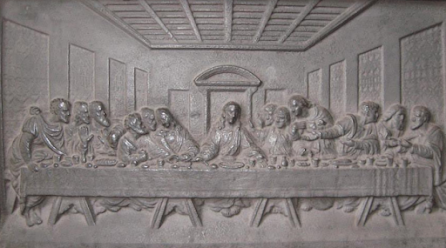 |
| The Last Supper in cast iron, as found in the Mercer Museum, Doylestown, PA |
That said, there is a social media trope out there that maintains that the tawdry performance was not meant to ridicule the Last Supper at all. That it was, instead, merely an attempt to mimic a well-known French painting showing the pagan gods at a Bacchanalian. Those who can not appreciate this homage to French art—so the trope goes—as performed by a bunch of overweight men prancing around in their granny's flapper garb, are ignorant, uneducated, intolerant, overly-sensitive, and otherwise bad people who can be safely ignored.
I took the time to research and respond to one such post that showed up in my feed. I am recording my findings here for posterity because I fully expect that my response will be summarily deleted by the original poster or memory-holed on the particular social media platform where I posted it.
For the record, the original painting was by a Dutchman, Jan Harmensz van Biljert, not a Frenchman. And the painting, The Feast of the Gods, is itself pretty clearly a parody of da Vinci's Last Supper, but with a Bacchanalian twist.
Furthermore, someone at Paris2024 apparently admitted to Washington Times reporter Valerie Richardson that the insipid performance was, in fact, "inspired" by the Last Supper.
Dear Valerie,Thank you for your inquiry. Please find below a statement, which can be attributed to a Paris 2024 spokesperson.“Clearly, there was never an intention to show disrespect towards any religious group or belief. On the contrary, each of the tableaux in the Paris 2024 Opening Ceremony were intended to celebrate community and tolerance.“For the ‘Festivities’ segment, Thomas Jolly took inspiration from Leonardo Da Vinci’s famous painting to create the setting. [Bold is mine] He is not the first artist to make reference to what is a world-famous work of art. From Andy Warhol to the Simpsons, many have done it before him.”Best,The Communication TeamParis 2024


No comments:
Post a Comment